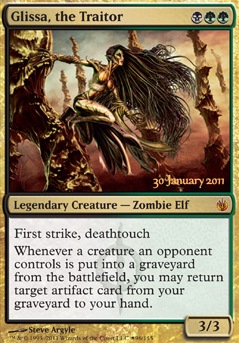
Glissa the dirty girl
Commander / EDH Artifact Attrition BG (Golgari) Control Infinite Combo Toolbox
Land (36)
-
1x
Ancient Tomb

- 1x Bayou
- 1x Bloodstained Mire
-
1x
Boseiju, Who Endures

-
1x
Cabal Coffers

- 1x Darkmoss Bridge
- 1x Exotic Orchard
-
1x
Forbidden Orchard

- 3x Forest
-
1x
Inventors' Fair

- 1x Marsh Flats
- 1x Misty Rainforest
- 1x Overgrown Tomb
- 1x Polluted Delta
- 1x Prismatic Vista
- 1x Reflecting Pool
- 1x Shifting Woodland
- 1x Spire of Industry
-
1x
Swamp

- 3x Swamp
- 1x Tree of Tales
- 1x Twilight Mire
- 1x Underground Mortuary
-
1x
Urborg, Tomb of Yawgmoth

- 1x Urza's Saga
- 1x Vault of Whispers
- 1x Verdant Catacombs
- 1x Windswept Heath
- 1x Witch's Cottage
- 1x Wooded Foothills
- 1x Yavimaya, Cradle of Growth
-
1x
Yavimaya Hollow

Sorcery (4)
Artifact (29)
- 1x Aetherflux Reservoir
-
1x
Bolas's Citadel

- 1x Crucible of Worlds
-
1x
Engineered Explosives

-
1x
Executioner's Capsule

- 1x Expedition Map
-
1x
Grinding Station

-
1x
Krark-Clan Ironworks

- 1x Lightning Greaves
-
1x
Lotus Petal

- 1x Mana Crypt
-
1x
Mana Vault

- 1x Mishra's Bauble
- 1x Mox Opal
- 1x Mystic Forge
-
1x
Nevinyrral's Disk

- 1x Oblivion Stone
- 1x Portal to Phyrexia
-
1x
Possessed Portal

- 1x Sensei's Divining Top
-
1x
Shadowspear

-
1x
Sol Ring

-
1x
Soul-Guide Lantern

-
1x
Sword of Feast and Famine

- 1x Tithing Blade Flip
- 1x Torpor Orb
- 1x Triangle of War
- 1x Urza's Bauble
-
1x
Wayfarer's Bauble

Enchantment (4)
Instant (1)
Commander (1)
Creature (25)
- 1x Arcbound Ravager
- 1x Argentum Masticore
- 1x Armix, Filigree Thrasher
- 1x Braids, Arisen Nightmare
-
1x
Butcher of Malakir

- 1x Cityscape Leveler
- 1x Foundry Inspector
-
1x
Hangarback Walker

- 1x Haywire Mite
-
1x
Heap Doll

- 1x Hope of Ghirapur
- 1x Imotekh the Stormlord
- 1x Jhoira's Familiar
-
1x
Kuldotha Forgemaster

- 1x Liberator, Urza's Battlethopter
- 1x Lokhust Heavy Destroyer
- 1x Metalworker
-
1x
Mycosynth Golem

-
1x
Myr Retriever

- 1x Orcish Bowmasters
- 1x Rankle, Master of Pranks
- 1x Sarinth Steelseeker
-
1x
Scrap Trawler

- 1x Scrapyard Recombiner
- 1x Walking Ballista
Sideboard
Artifact (5)
Land (1)
Maybeboard
Artifact (7)
- 1x Nihil Spellbomb
- 1x Plague Boiler
- 1x Ratchet Bomb
- 1x Slagstone Refinery
- 1x Vat of Rebirth
- 1x Viridian Longbow
- 1x Wishclaw Talisman
Planeswalker (1)
Creature (6)
- 1x Necron Deathmark
- 1x Phyrexian Revoker
- 1x Solemn Simulacrum
- 1x Steel Hellkite
-
1x
Wurmcoil Engine

- 1x Zenith Chronicler
Enchantment (1)
Land (3)
Instant (2)
Suggestions
Updates Add
Comments
Attention! Complete Comment Tutorial! This annoying message will go away once you do!
Important! Formatting tips — Comment Tutorial — markdown syntax
Please login to comment
Casual
99% Competitive
Revision 112 See all
(10 months ago)
| +1 | Arcbound Condor | side |
| -1 | Forest | main |
| +1 | Shifting Woodland | main |
| Date added | 7 years |
| Last updated | 10 months |
| Legality | This deck is not Commander / EDH legal. |
| Rarity (main - side) | 18 - 1 Mythic Rares 51 - 3 Rares 16 - 3 Uncommons 8 - 2 Commons |
| Cards | 100 |
| Avg. CMC | 2.81 |
| Tokens | Construct 0/0 C, Myr 1/1 C, Necron Warrior 2/2 B, Orc Army, Plant 0/2 G, Powerstone, Spirit 1/1 C, Thopter 1/1 C, Wurm 3/3 C w/ Deathtouch, Wurm 3/3 C w/ Lifelink |
| Folders | ARTIFACT CMDR DECKS, Neat Decks, EDH, inspirational decks, Commander, idk, EDH Ideas, Glissa, the Traitor, Decks to look at |
| Votes | |
| Ignored suggestions | |
| Shared with | |
| Views |

